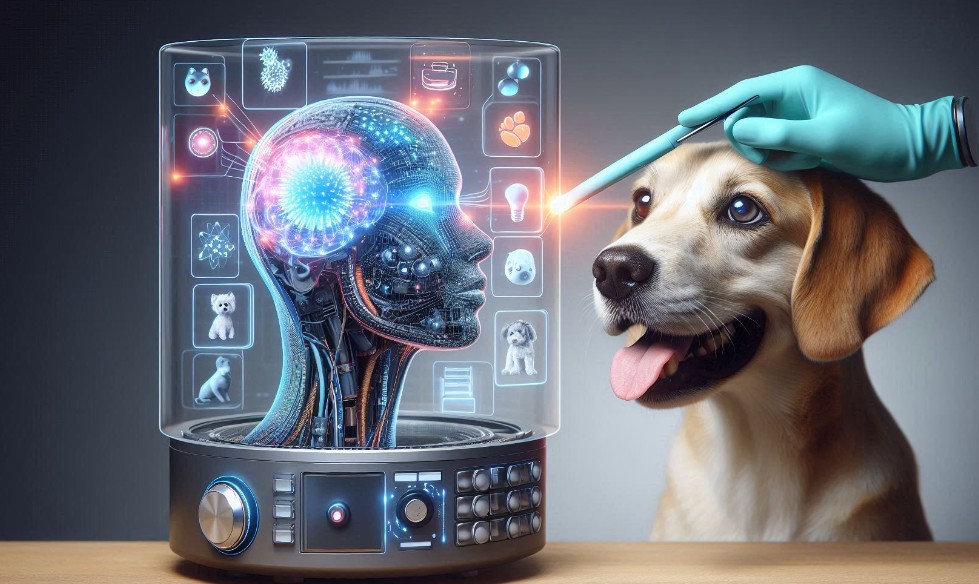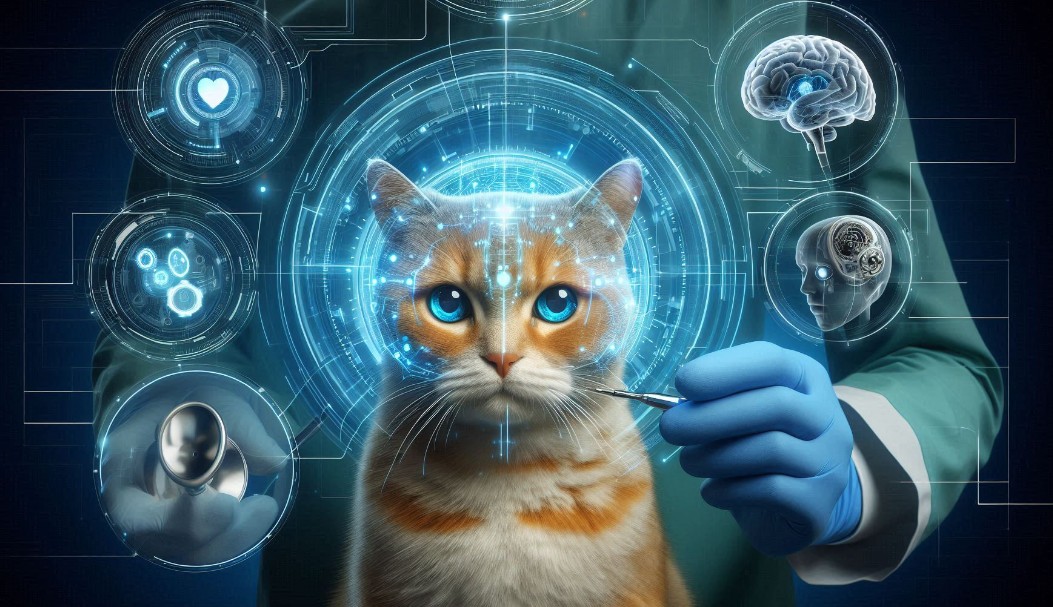In recent years, there has been a significant advancement in the field of Artificial Intelligence (AI) and Augmented Reality (AR). These technologies have become increasingly popular and have the potential to enhance virtual experiences in various fields such as gaming, education, healthcare, and...
Artificial Intelligence Advances in Understanding Pet Emotions

The bond between humans and their pets is a unique and cherished relationship, characterized by an intuitive understanding of each other's emotions. However, as much as we love our furry companions, accurately interpreting their feelings can sometimes be a challenge. Recent advancements in artificial intelligence (AI) are poised to bridge this gap, offering a groundbreaking approach to understanding pet emotions with unprecedented accuracy.
Leveraging sophisticated machine learning algorithms, researchers have developed AI systems capable of analyzing and interpreting the subtle cues that indicate a pet's emotional state. These systems examine a variety of inputs, including facial expressions, body language, and vocalizations, to provide a comprehensive assessment of how an animal is feeling. This technology not only enhances our ability to care for pets but also deepens the emotional connection we share with them.
One of the most exciting aspects of this innovation is its potential applications in both everyday pet ownership and veterinary care. By integrating AI-driven emotion recognition into pet products, such as smart collars and interactive toys, owners can gain real-time insights into their pets' emotional well-being. Furthermore, veterinarians can utilize this technology to more accurately diagnose and treat conditions that may be linked to stress or anxiety, ultimately improving the overall quality of life for pets.
The journey towards fully understanding the emotional world of our pets is just beginning, but the progress made so far is promising. As AI continues to evolve, it holds the potential to revolutionize the way we interact with and care for our animal companions, ensuring that their needs are met with empathy and precision.
Artificial Intelligence and Pet Emotion Recognition
Artificial intelligence (AI) is making significant strides in various fields, and one of the emerging areas is the recognition of pet emotions. This technological advancement has the potential to revolutionize the way we understand and interact with our pets, enhancing their care and well-being.
Understanding pet emotions can be challenging due to the lack of verbal communication. However, AI-powered systems can analyze a variety of cues to determine a pet's emotional state. Here are some key aspects of how AI is being used in pet emotion recognition:
- Facial Recognition: Advanced algorithms can analyze the facial expressions of pets to identify emotions such as happiness, sadness, anger, and fear. This technology is similar to human facial recognition but tailored to the unique facial structures of different animals.
- Vocal Analysis: AI systems can interpret the sounds made by pets, such as barks, meows, and chirps. By analyzing pitch, frequency, and patterns, these systems can infer emotions and needs.
- Body Language: The position of a pet's body, tail, and ears can provide significant insights into their emotional state. AI can process video feeds to detect these subtle cues and offer real-time emotional assessments.
- Behavioral Patterns: Monitoring changes in behavior, such as eating habits, activity levels, and sleeping patterns, can help AI identify stress, anxiety, or illness in pets.
The benefits of AI in pet emotion recognition are vast:
- Improved Veterinary Care: Early detection of emotional distress can lead to timely medical intervention, improving health outcomes for pets.
- Enhanced Bonding: Understanding a pet's emotions can strengthen the bond between pet and owner, leading to a more fulfilling relationship.
- Customized Training: Tailoring training methods to a pet's emotional responses can result in more effective and humane training practices.
- Better Welfare: Identifying stressors and sources of discomfort can help in creating a more comfortable and stress-free environment for pets.
As AI continues to evolve, the accuracy and capabilities of pet emotion recognition systems are expected to improve, making them an invaluable tool for pet owners, veterinarians, and animal behaviorists. Embracing this technology could lead to significant advancements in animal welfare and deepen our understanding of the complex emotional lives of our pets.
Advancements in AI for Understanding Pets
Artificial intelligence has made significant strides in recent years, extending its capabilities to areas that were once thought to be the exclusive domain of humans. One particularly exciting development is the application of AI to understand the emotions and behaviors of pets. This technology promises not only to enhance the bond between pet owners and their animals but also to improve the overall well-being of pets.
Emotion Recognition
AI systems are now being designed to recognize and interpret the emotional states of pets through various indicators such as facial expressions, vocalizations, and body language. These systems use advanced machine learning algorithms to analyze data collected from cameras and microphones. By identifying subtle cues, AI can differentiate between emotions such as happiness, fear, anxiety, and excitement in pets.
For instance, a dog's wagging tail or a cat's purring can be accurately interpreted by AI to understand whether the animal is content or stressed. This capability allows pet owners to respond more appropriately to their pets' needs, fostering a healthier and more communicative relationship.
Behavioral Analysis
Beyond emotion recognition, AI is also being employed to analyze pet behavior. By continuously monitoring pets and tracking their activities, AI can identify patterns and detect any unusual behaviors that might indicate health issues or distress. This proactive approach enables early intervention, potentially preventing more serious health problems.
For example, if an AI system detects that a dog is pacing excessively or a cat is hiding more often than usual, it can alert the owner to these changes, prompting a visit to the veterinarian. This level of vigilance can be particularly beneficial for older pets or those with chronic health conditions.
Personalized Care
AI's ability to understand individual pets' needs also extends to personalized care. By analyzing data specific to each pet, such as their age, breed, medical history, and typical behavior patterns, AI can offer customized recommendations for diet, exercise, and enrichment activities. This tailored approach ensures that pets receive the care best suited to their unique requirements, enhancing their quality of life.
Furthermore, AI-powered devices such as smart feeders and interactive toys can adapt to a pet's preferences and behaviors in real-time, providing a more engaging and stimulating environment. This not only keeps pets physically active but also mentally stimulated, reducing the risk of boredom and related behavioral issues.
Conclusion
The advancements in AI for understanding pets mark a significant milestone in the intersection of technology and animal care. By leveraging AI's capabilities in emotion recognition, behavioral analysis, and personalized care, pet owners can gain deeper insights into their pets' well-being and foster a more nurturing and responsive relationship. As this technology continues to evolve, the future holds even greater potential for enhancing the lives of pets and their human companions.

How AI Identifies Animal Emotions
Artificial intelligence has made significant strides in understanding human emotions, and now it is extending this capability to the animal kingdom. Identifying animal emotions is a complex task, as it involves interpreting subtle cues from body language, vocalizations, and physiological signals. Here’s how AI achieves this intricate understanding:
Firstly, AI systems are trained using vast datasets of animal behavior. These datasets include images, videos, and audio recordings of animals in various emotional states. Machine learning algorithms analyze these data to recognize patterns associated with different emotions. For instance, a dog’s wagging tail or a cat’s purring can be indicative of happiness, while a raised hackle or hissing might signify aggression or fear.
The process can be broken down into several key steps:
| Step | Description |
|---|---|
| Data Collection | Gathering extensive datasets of animal behaviors and emotions from videos, images, and audio recordings. |
| Feature Extraction | Identifying and extracting key features such as facial expressions, body postures, and vocal patterns. |
| Model Training | Training machine learning models using the extracted features to recognize and classify different emotional states. |
| Real-time Analysis | Deploying the trained models to analyze live or recorded data to identify emotions in real time. |
| Validation | Validating the AI's predictions against known emotional states to ensure accuracy and reliability. |
In addition to visual and auditory cues, AI can also utilize physiological data. Wearable devices for pets can monitor heart rate, body temperature, and other physiological indicators to provide a comprehensive understanding of the animal's emotional state. This multimodal approach enhances the accuracy of emotion detection.
The implications of AI identifying animal emotions are profound. It can improve animal welfare by enabling better understanding and care, assist veterinarians in diagnosing and treating emotional distress, and enhance the bond between pets and their owners through improved communication. As AI technology continues to evolve, its ability to empathize with our furry friends will only become more sophisticated and impactful.
Impact of Emotion Recognition on Pet Care
Emotion recognition technology for pets is revolutionizing the way we care for our animal companions. By understanding the emotional states of pets, owners and veterinarians can significantly enhance the quality of life for pets. This technological advancement is bridging the communication gap between humans and animals, leading to more empathetic and effective pet care.
Enhancing Veterinary Care
One of the most significant impacts of emotion recognition technology is in the realm of veterinary care. Veterinarians can use these tools to better diagnose and treat illnesses. For example, recognizing signs of chronic pain or discomfort that an animal might otherwise hide can lead to earlier interventions and more effective treatments. Emotion recognition can also assist in assessing the stress levels of pets in clinical environments, allowing for more tailored and compassionate care plans.
Improving Pet-Owner Relationships
For pet owners, emotion recognition tools offer a deeper understanding of their pets' needs and feelings. This can lead to more meaningful interactions and stronger bonds. Owners can learn to identify signs of anxiety, happiness, or frustration, which can help in modifying their own behaviors to better suit their pets' emotional well-being. For instance, recognizing that a dog is anxious during thunderstorms can prompt an owner to provide comforting interventions, thus reducing the pet's stress.
Additionally, emotion recognition can assist in training and behavior modification. By understanding the emotional triggers behind certain behaviors, owners can develop more effective and humane training methods. This technology can also help in managing the mental health of pets, ensuring that they live healthier, happier lives.
Overall, the integration of emotion recognition technology into pet care practices represents a significant advancement in our ability to provide empathetic and informed care for our animal companions. As this technology continues to evolve, its potential to transform pet care for the better is vast and promising.



